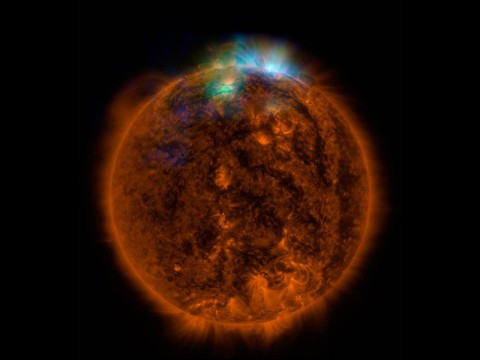Written by Dr. Tony Phillips
Science at NASA
 Washington, D.C. – When you attach the prefix “nano” to something, it usually means “very small.” Solar flares appear to be the exception.
Washington, D.C. – When you attach the prefix “nano” to something, it usually means “very small.” Solar flares appear to be the exception.
Researchers are studying a type of explosion on the sun called a ‘nanoflare.’ A billion times less energetic than ordinary flares, nanoflares have a power that belies their name.
“A typical ‘nanoflare’ has the same energy as 240 megatons of TNT,” says physicist David Smith of UC Santa Cruz. “That would be something like 10,000 atomic fission bombs.”
The sun can go days, weeks or even months without producing an ordinary solar flare. Nanoflares, on the other hand, are crackling on the sun almost non-stop.
“They appear as little brightenings of the solar surface at extreme ultraviolet and X-ray wavelengths,” continues Smith. “The first sightings go back to Skylab in the 1970s.”
The relentless crackle of nanoflares might solve a long-standing mystery in solar physics: What causes the sun’s corona to be so hot?
Imagine standing in front of a roaring fire. You feel the warmth of the flames. Now back away. You get cooler, right?
That’s not how it works on the sun. The visible surface of the sun has a temperature of 5500 C. Moving away from the surface should provide some relief. Instead, the sun’s upper atmosphere, known as the “solar corona,” sizzles at a million degrees–a temperature almost 200 times higher than that of the roaring furnace below.

For more than a half-century, astronomers have tried to figure out what causes the corona to be so hot. Every year or so, a press release appears purporting to solve the mystery, only to be shot down by a competing theory a year or so later. It is one of the most vexing problems in astrophysics.
Smith thinks nanoflares might be involved. For one thing, they appear to be active throughout the solar cycle, which would explain why the corona remains hot during Solar Minimum. And while each individual nanoflare falls short of the energy required to heat the sun’s atmosphere, collectively they might have no trouble doing to job.
To investigate this possibility, Smith turned to a telescope designed to study something completely different.
Smith contacted the principal investigator, Fiona Harrison of the California Institute of Technology in Pasadena, to see what she thought.
“At first I thought the whole idea was crazy,” says Harrison. “Why would we have the most sensitive high energy X-ray telescope ever built, designed to peer deep into the universe, look at something in our own back yard?”
Eventually, she was convinced. As Smith explained, NuSTAR has just the right combination of sensitivity and resolution to study the telltale X-ray flickers of nanoflares. A test image they took in late 2014 removed any doubt. NuSTAR turned toward the sun and, working together with NASA’s Solar Dynamics Observatory, captured one of the most beautiful images in the history of solar astronomy.
The next step, says Smith, is to wait for Solar Minimum. The current solar cycle will wind down in the years ahead, leaving the sun mostly free of sunspots and other magnetic clutter that can obscure nanoflares. NuSTAR will be able to survey the stellar surface and gather data on these explosions like no telescope has done before.
Will it solve the mystery of nanoflares and the solar corona? “I don’t know,” says Smith, “but I cannot wait to try.”


